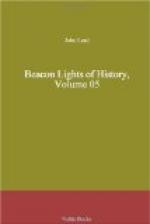And then sets in the new era, which begins with Michael Angelo. It is marked by the revival of Greek art and Greek literature. At Florence reign the Medici. On the throne of Saint Peter sits an Alexander VI. or a Julius II. Genoa is a city of merchant-palaces. Museums are collected of the excavated remains of Roman antiquity. Everybody kindles with the contemplation of the long-buried glories of a classic age; everybody reads the classic authors: Cicero is a greater oracle than Saint Augustine. Scholars flock to Italy. The popes encourage the growing taste for Pagan philosophy. Ancient art regains her long-abdicated throne, and wields her sceptre over the worshippers of the Parthenon and the admirers of Aeschylus and Thucydides. With the revived statues of Greece appear the most beautiful pictures ever produced by the hand of man; and with pictures and statues architecture receives a new development. It is the blending of the old Greek and Roman with the Gothic, and is called the Renaissance. Michael Angelo erects St. Peter’s, the heathen Pantheon, on the intersection of Gothic nave and choir and transept; a glorious dome, more beautiful than any Gothic spire or tower, rising four hundred and fifty feet into the air. And in the interior are classic circular arches and pillars, so vast that one is impressed as with great feats of engineering skill. All that is variegated in marbles adorns the altars; all that is bewitching in paintings is transferred to mosaics. And this new style of Italy spreads into France and England. Sir Christopher Wren builds St. Paul’s,—more Grecian than Gothic,—and fills London with new churches, not one of which is Gothic, and all different. The brain is bewildered in attempting to classify the new and ever-shifting forms of the revived Italian. And so for three hundred years the architects mingle the Gothic with the classical, until now a mongrel architecture is the disgrace of Europe; varied but not expressive, resting on no settled principles, neither on vertical nor on horizontal lines,—blended together, sometimes Grecian porticos on Elizabethan structures, spires resting not on towers but roofs, Byzantine domes on Grecian temples, Greek columns with Lombard arches, flamboyant panelling, pendant pillars from the roof, all styles mixed up together, Corinthian pilasters acting as Gothic buttresses, and pointed arches with Doric friezes,—a heap of diverse forms, alien alike from the principles of Wykeham and Vitruvius.
And this varied mongrel style of architecture corresponds with the confused civilization of the period,—neither Greek nor Gothic, but a mixture of both; intolerant priests wrangling with pagan sceptics and infidels,—Aquaviva with Pascal, the hierarchy of the French Church with Voltaire and Rousseau, Protestant divines with the Catholic clergy; Geneva and Rome compromising at Oxford, the authority of the Fathers made antagonistic to the authority of popes, new vernacular tongues supplanting




